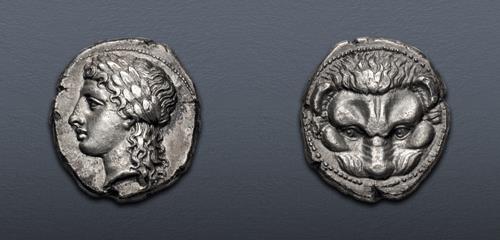
|
BRUTTIUM, Rhegion. Circa 356-351 BC. AR Tetradrachm (24mm, 17.11 g, 9h). Near EF.
CNG Feature Auction 124
Lot: 42. Estimated: $ 20 000
Greek, Coin-in-Hand Video, Silver
Sold For $ 25 000. This amount does not include the buyer’s fee.
Go to Live
|
|
BRUTTIUM, Rhegion. Circa 356-351 BC. AR Tetradrachm (24mm, 17.11 g, 9h). Head of Apollo left, with long hair, wearing laurel wreath; [PHΓINOΣ to left] / Lion mask facing. Herzfelder 115bis (D71/R97a); HN Italy 2501; SNG ANS 676 (same obv. die); SNG Lloyd 700 (same dies); BMC 36 (same dies); Jameson 460A (same dies). Toned, some find patina, flan flaw and light scratch on obverse. Near EF. Fine style tetradrachm from the final silver series at Rhegion.
Dionysios I, after concluding a peace with the Carthaginians, went about securing his power in the island of Sicily. His troops, however, rebelled against him and sought help from, among others, the city of Rhegion (Diod. Sic. 14.8.2). In the ensuing campaigns, Dionyios I proceeded to enslave the citizens of Naxos and Katane, with whom the Rhegians shared a common history and identity (Diod. Sic. 14.40.1). This association was a source of anger and fear for the inhabitants of Rhegion. The Syracusan exiles living there also encouraged the Rhegians to go to war with Syracuse (Diod. Sic. 14.40.3). The overarching strategy of Dionysios I included extending his power into Italy by using Rhegion as a stepping stone to the rest of the peninsula. In 387 BC, after a siege that lasted eleven months, the Rhegians, on the brink of starvation, surrendered to Dionysios. Indeed, we are told that by the end of the siege, a medimnos of wheat cost about five minai (Diod. Sic. 14.111.2). Strabo remarks that, following Dionysios' capture of the city, the Syracusan “destroyed the illustrious city” (Strabo 6.1.6).
The next decade or so of the history of Rhegion is unclear, but sometime during his reign, Dionysios II, who succeeded his father in 367 BC, rebuilt the city, giving it the new name of Phoibia (Strabo 6.1.6). Herzfelder argues that this issue was struck by Dionysios II of Syracuse after he rebuilt the city, and dates it to the period that Dionysios II is thought to have lived there. Due to civil strife at Syracuse, Dionysios II was forced to garrison Rhegion, but was ejected from the city by two of his rivals circa 351 BC (Diod. Sic. 16.45.9). This event marked the end of the silver coinage at Rhegion.
These tetradrachms of Rhegion exemplify the high aesthetic standard of the Classical Period that is common to the coins of Magna Graecia at this time. The facing lion head is rendered in a bold, detailed manner, as is the head of Apollo, carefully depicted as a serene deity. What separates these coins from their contemporaries is the depth of the relief, which was extraordinarily high. The effect is particularly striking on the reverse, where the lion head has an exceptional three-dimensional quality that is unsurpassed.
The final winners of all CNG Feature Auction 124 lots will be determined during the live online sale that will be held on 19-20 September 2023. This lot is in Session One, which will begin 19 September at 9 AM ET.
Winning bids are subject to a 22.5% buyer's fee for bids placed on this website and 25% for all others.
We recognize that our users may have various Internet Browsers and Operating Systems. We like our visitors to have the best possible experience when using our bidding platform. However, we do recognize that it is impossible to develop applications that work identically, efficiently and effectively on all web browsers. The CNG bidding platform supports the latest stable major version and stable previous version of Chrome and Firefox.
|
